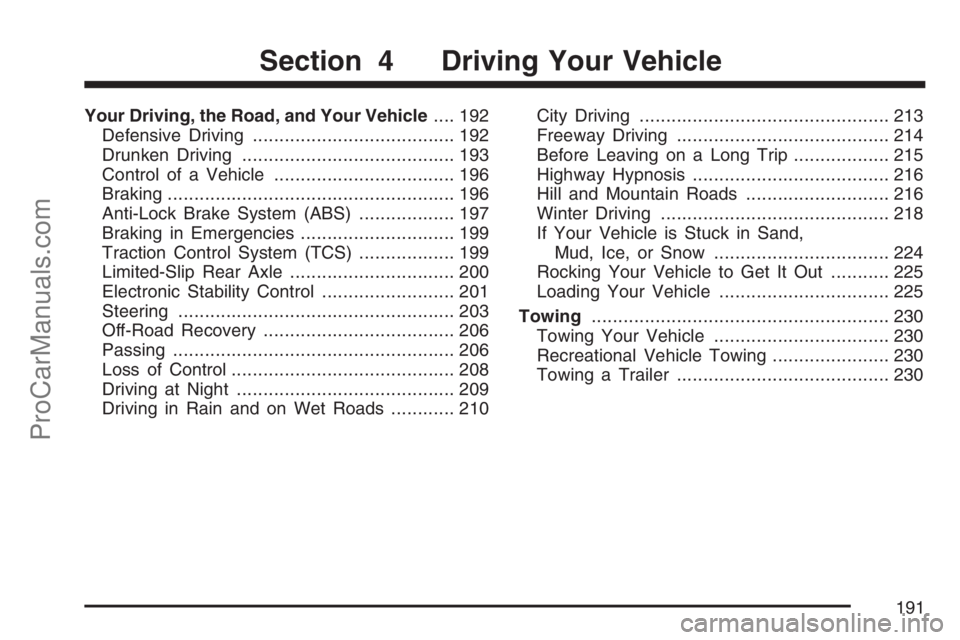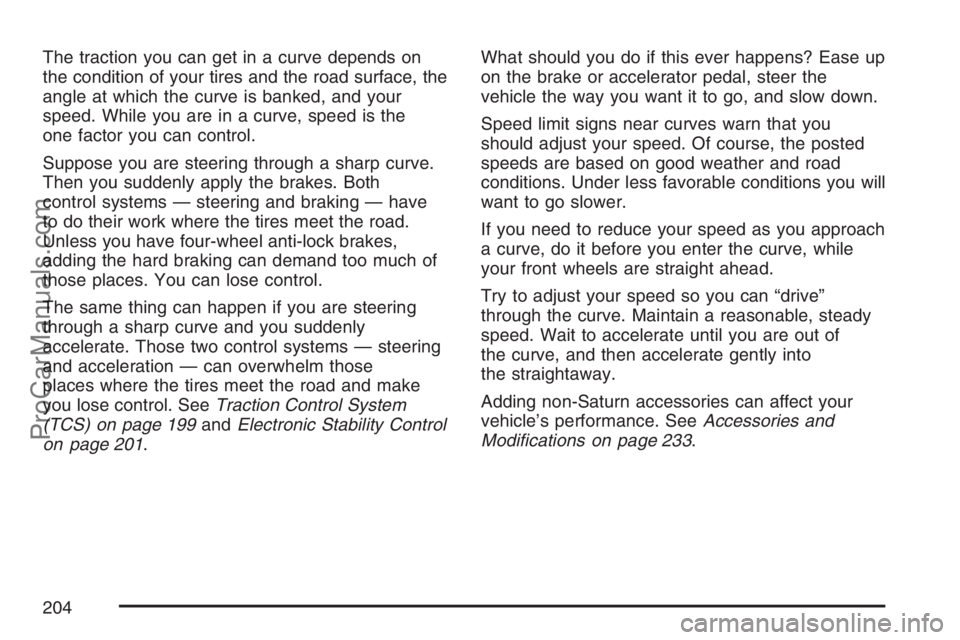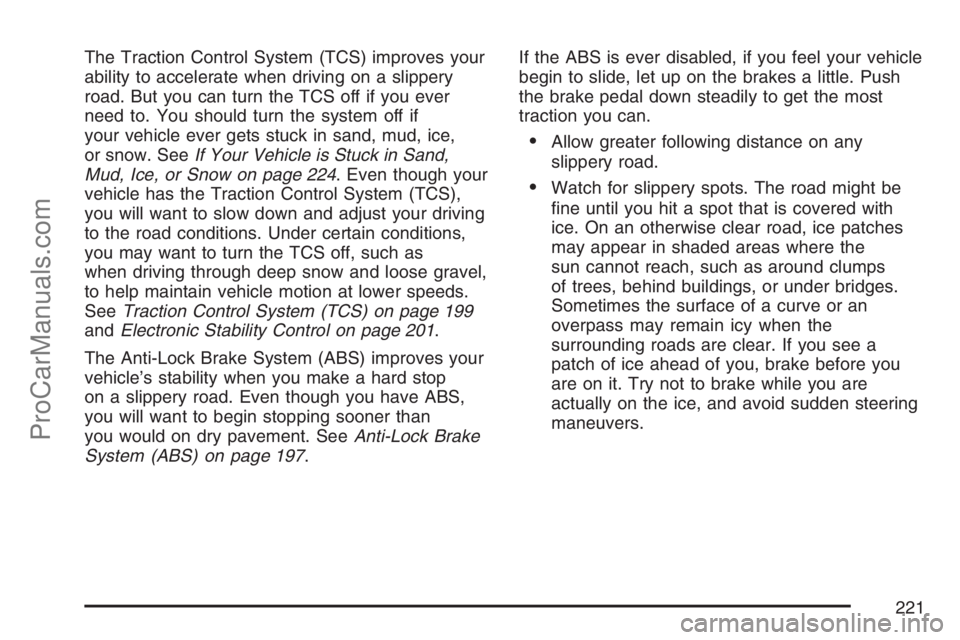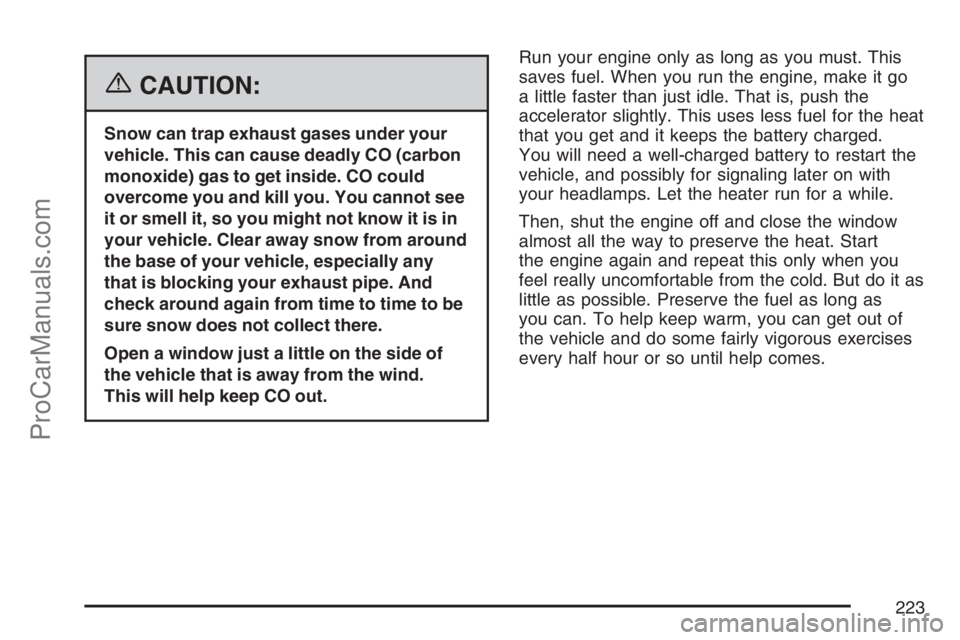lock SATURN SKY 2007 Repair Manual
[x] Cancel search | Manufacturer: SATURN, Model Year: 2007, Model line: SKY, Model: SATURN SKY 2007Pages: 384, PDF Size: 2.47 MB
Page 191 of 384

Your Driving, the Road, and Your Vehicle.... 192
Defensive Driving...................................... 192
Drunken Driving........................................ 193
Control of a Vehicle.................................. 196
Braking...................................................... 196
Anti-Lock Brake System (ABS).................. 197
Braking in Emergencies............................. 199
Traction Control System (TCS).................. 199
Limited-Slip Rear Axle............................... 200
Electronic Stability Control......................... 201
Steering.................................................... 203
Off-Road Recovery.................................... 206
Passing..................................................... 206
Loss of Control.......................................... 208
Driving at Night......................................... 209
Driving in Rain and on Wet Roads............ 210City Driving............................................... 213
Freeway Driving........................................ 214
Before Leaving on a Long Trip.................. 215
Highway Hypnosis..................................... 216
Hill and Mountain Roads........................... 216
Winter Driving........................................... 218
If Your Vehicle is Stuck in Sand,
Mud, Ice, or Snow ................................. 224
Rocking Your Vehicle to Get It Out........... 225
Loading Your Vehicle................................ 225
Towing........................................................ 230
Towing Your Vehicle ................................. 230
Recreational Vehicle Towing...................... 230
Towing a Trailer........................................ 230
Section 4 Driving Your Vehicle
191
ProCarManuals.com
Page 197 of 384

Avoid needless heavy braking. Some people drive
in spurts — heavy acceleration followed by
heavy braking — rather than keeping pace with
traffic. This is a mistake. The brakes may not have
time to cool between hard stops. The brakes
will wear out much faster if you do a lot of heavy
braking. If you keep pace with the traffic and
allow realistic following distances, you will
eliminate a lot of unnecessary braking. That means
better braking and longer brake life.
If your vehicle’s engine ever stops while you are
driving, brake normally but do not pump the
brakes. If you do, the pedal may get harder to
push down. If the engine stops, you will still have
some power brake assist. But you will use it
when you brake. Once the power assist is used
up, it may take longer to stop and the brake pedal
will be harder to push.
Adding non-Saturn accessories can affect your
vehicle’s performance. SeeAccessories and
Modi�cations on page 233.Anti-Lock Brake System (ABS)
Your vehicle has the Anti-Lock Brake System
(ABS), an advanced electronic braking system
that will help prevent a braking skid.
When you start your engine and begin to drive
away, ABS will check itself. You may hear a
momentary motor or clicking noise while this test
is going on, and you may even notice that
your brake pedal moves a little. This is normal.
If there is a problem
with ABS, this warning
light will stay on.
SeeAnti-Lock Brake
System Warning
Light on page 135.
197
ProCarManuals.com
Page 199 of 384

Remember: ABS does not change the time you
need to get your foot up to the brake pedal or
always decrease stopping distance. If you get too
close to the vehicle in front of you, you will not have
time to apply your brakes if that vehicle suddenly
slows or stops. Always leave enough room up
ahead to stop, even though you have ABS.
Using ABS
Do not pump the brakes. Just hold the brake pedal
down �rmly and let anti-lock work for you. You may
hear the anti-lock pump or motor operate, and feel
the brake pedal pulsate, but this is normal.
Braking in Emergencies
With ABS, you can steer and brake at the same
time. In many emergencies, steering can help you
more than even the very best braking.
Traction Control System (TCS)
Your vehicle may have a traction control
system called TCS that limits wheel spin. This
is especially useful in slippery road conditions.The system operates only if it senses that the rear
wheels are spinning too much or are beginning
to lose traction. When this happens, the system
works the rear brakes and reduces engine
power (by closing the throttle and managing
engine spark) to limit wheel spin.
This light will �ash
when your traction
control system is
limiting wheel spin.
You may feel or hear
the system working,
but this is normal.
SeeElectronic Stability Control (ESC)/Traction
Control System (TCS) Indicator/Warning Light
(2.0L Engine Only) on page 136for more
information.
If your vehicle is in cruise control when the
traction control system begins to limit wheel spin,
the cruise control will automatically disengage.
When road conditions allow you to safely
use it again, you may re-engage the cruise control.
SeeTurn Signal/Multifunction Lever on page 111.
199
ProCarManuals.com
Page 201 of 384

Electronic Stability Control
Your vehicle may be equipped with an Electronic
Stability Control (ESC) system which combines
antilock brake, traction and stability control
systems and helps the driver maintain directional
control of the vehicle in most driving conditions.
When you �rst start your vehicle and begin to drive
away, the system performs several diagnostic
checks to ensure there are no problems. You may
hear or feel the system working. This is normal
and does not mean there is a problem with
your vehicle. The system should initialize before
the vehicle reaches 20 mph (32 km/h). In
some cases, it may take approximately two miles
of driving before the system initializes.
If the system fails to turn on or activate, the
ESC/TCS light will be on solid, and the ESC
OFF or SERVICE ESC message will be displayed.
For more information, seeDriver Information
Center (DIC) on page 144andElectronic Stability
Control (ESC)/Traction Control System (TCS)
Indicator/Warning Light (2.0L Engine Only)
on page 136.This light is located
on the instrument
panel cluster.
It will �ash when the ESC system is both on and
activated. You may also feel or hear the system
working; this is normal.
When the light is on solid and either the SERVICE
ESC or ESC OFF message is displayed, the
system will not assist the driver maintain
directional control of the vehicle. Adjust your
driving accordingly. SeeDIC Warnings and
Messages on page 147.
SeeElectronic Stability Control (ESC)/Traction
Control System (TCS) Indicator/Warning Light
(2.0L Engine Only) on page 136for more
information.
201
ProCarManuals.com
Page 204 of 384

The traction you can get in a curve depends on
the condition of your tires and the road surface, the
angle at which the curve is banked, and your
speed. While you are in a curve, speed is the
one factor you can control.
Suppose you are steering through a sharp curve.
Then you suddenly apply the brakes. Both
control systems — steering and braking — have
to do their work where the tires meet the road.
Unless you have four-wheel anti-lock brakes,
adding the hard braking can demand too much of
those places. You can lose control.
The same thing can happen if you are steering
through a sharp curve and you suddenly
accelerate. Those two control systems — steering
and acceleration — can overwhelm those
places where the tires meet the road and make
you lose control. SeeTraction Control System
(TCS) on page 199andElectronic Stability Control
on page 201.What should you do if this ever happens? Ease up
on the brake or accelerator pedal, steer the
vehicle the way you want it to go, and slow down.
Speed limit signs near curves warn that you
should adjust your speed. Of course, the posted
speeds are based on good weather and road
conditions. Under less favorable conditions you will
want to go slower.
If you need to reduce your speed as you approach
a curve, do it before you enter the curve, while
your front wheels are straight ahead.
Try to adjust your speed so you can “drive”
through the curve. Maintain a reasonable, steady
speed. Wait to accelerate until you are out of
the curve, and then accelerate gently into
the straightaway.
Adding non-Saturn accessories can affect your
vehicle’s performance. SeeAccessories and
Modi�cations on page 233.
204
ProCarManuals.com
Page 205 of 384

Steering in Emergencies
There are times when steering can be more
effective than braking. For example, you come
over a hill and �nd a truck stopped in your lane,
or a car suddenly pulls out from nowhere, or
a child darts out from between parked cars
and stops right in front of you. You can avoid
these problems by braking — if you can stop in
time. But sometimes you cannot; there is not room.
That is the time for evasive action — steering
around the problem.
Your vehicle can perform very well in emergencies
like these. First apply your brakes. SeeBraking
on page 196. It is better to remove as much speed
as you can from a possible collision. Then steer
around the problem, to the left or right depending
on the space available.An emergency like this requires close attention and
a quick decision. If you are holding the steering
wheel at the recommended 9 and 3 o’clock
positions, you can turn it a full 180 degrees very
quickly without removing either hand. But you
have to act fast, steer quickly, and just as quickly
straighten the wheel once you have avoided
the object.
The fact that such emergency situations are always
possible is a good reason to practice defensive
driving at all times and wear safety belts properly.
205
ProCarManuals.com
Page 209 of 384

Remember: Any Anti-Lock Brake System (ABS)
helps avoid only the braking skid.
If the ABS is ever disabled, in a braking skid,
where the wheels are no longer rolling, release
enough pressure on the brakes to get the wheels
rolling again. This restores steering control.
Push the brake pedal down steadily when you
have to stop suddenly. As long as the wheels are
rolling, you will have steering control.
Driving at Night
Night driving is more dangerous than day driving.
One reason is that some drivers are likely to
be impaired — by alcohol or drugs, with night
vision problems, or by fatigue.
Here are some tips on night driving.
Drive defensively.
Do not drink and drive.
Adjust the inside rearview mirror to reduce the
glare from headlamps behind you.
Since you cannot see as well, you may need
to slow down and keep more space between
you and other vehicles.
Slow down, especially on higher speed roads.
Your vehicle’s headlamps can light up only so
much road ahead.
In remote areas, watch for animals.
If you are tired, pull off the road in a safe
place and rest.
No one can see as well at night as in the daytime.
But as we get older these differences increase.
A 50-year-old driver may require at least twice as
much light to see the same thing at night as a
20-year-old.
What you do in the daytime can also affect your
night vision. For example, if you spend the
day in bright sunshine you are wise to wear
sunglasses. Your eyes will have less trouble
adjusting to night. But if you are driving, do not
wear sunglasses at night. They may cut down on
glare from headlamps, but they also make a
lot of things invisible.
You can be temporarily blinded by approaching
headlamps. It can take a second or two, or
even several seconds, for your eyes to re-adjust
to the dark.
209
ProCarManuals.com
Page 221 of 384

The Traction Control System (TCS) improves your
ability to accelerate when driving on a slippery
road. But you can turn the TCS off if you ever
need to. You should turn the system off if
your vehicle ever gets stuck in sand, mud, ice,
or snow. SeeIf Your Vehicle is Stuck in Sand,
Mud, Ice, or Snow on page 224. Even though your
vehicle has the Traction Control System (TCS),
you will want to slow down and adjust your driving
to the road conditions. Under certain conditions,
you may want to turn the TCS off, such as
when driving through deep snow and loose gravel,
to help maintain vehicle motion at lower speeds.
SeeTraction Control System (TCS) on page 199
andElectronic Stability Control on page 201.
The Anti-Lock Brake System (ABS) improves your
vehicle’s stability when you make a hard stop
on a slippery road. Even though you have ABS,
you will want to begin stopping sooner than
you would on dry pavement. SeeAnti-Lock Brake
System (ABS) on page 197.If the ABS is ever disabled, if you feel your vehicle
begin to slide, let up on the brakes a little. Push
the brake pedal down steadily to get the most
traction you can.
Allow greater following distance on any
slippery road.
Watch for slippery spots. The road might be
�ne until you hit a spot that is covered with
ice. On an otherwise clear road, ice patches
may appear in shaded areas where the
sun cannot reach, such as around clumps
of trees, behind buildings, or under bridges.
Sometimes the surface of a curve or an
overpass may remain icy when the
surrounding roads are clear. If you see a
patch of ice ahead of you, brake before you
are on it. Try not to brake while you are
actually on the ice, and avoid sudden steering
maneuvers.
221
ProCarManuals.com
Page 223 of 384

{CAUTION:
Snow can trap exhaust gases under your
vehicle. This can cause deadly CO (carbon
monoxide) gas to get inside. CO could
overcome you and kill you. You cannot see
it or smell it, so you might not know it is in
your vehicle. Clear away snow from around
the base of your vehicle, especially any
that is blocking your exhaust pipe. And
check around again from time to time to be
sure snow does not collect there.
Open a window just a little on the side of
the vehicle that is away from the wind.
This will help keep CO out.Run your engine only as long as you must. This
saves fuel. When you run the engine, make it go
a little faster than just idle. That is, push the
accelerator slightly. This uses less fuel for the heat
that you get and it keeps the battery charged.
You will need a well-charged battery to restart the
vehicle, and possibly for signaling later on with
your headlamps. Let the heater run for a while.
Then, shut the engine off and close the window
almost all the way to preserve the heat. Start
the engine again and repeat this only when you
feel really uncomfortable from the cold. But do it as
little as possible. Preserve the fuel as long as
you can. To help keep warm, you can get out of
the vehicle and do some fairly vigorous exercises
every half hour or so until help comes.
223
ProCarManuals.com
Page 232 of 384

Tires............................................................ 284
Winter Tires.............................................. 286
Tire Sidewall Labeling............................... 287
Tire Terminology and De�nitions............... 289
In�ation - Tire Pressure............................. 292
Tire Inspection and Rotation...................... 294
When It Is Time for New Tires.................. 296
Buying New Tires...................................... 296
Different Size Tires and Wheels................ 298
Uniform Tire Quality Grading..................... 299
Wheel Alignment and Tire Balance............ 300
Wheel Replacement.................................. 300
Tire Chains............................................... 303
If a Tire Goes Flat.................................... 303
Tire In�ator Kit.......................................... 304
Appearance Care........................................ 315
Cleaning the Inside of Your Vehicle.......... 315
Fabric/Carpet............................................. 316
Leather...................................................... 317
Instrument Panel, Vinyl, and
Other Plastic Surfaces........................... 317
Care of Safety Belts.................................. 318
Weatherstrips............................................ 318
Washing Your Vehicle............................... 318Cleaning Exterior Lamps/Lenses................ 319
Finish Care............................................... 319
Windshield and Wiper Blades.................... 319
Convertible Top......................................... 320
Aluminum or Chrome-Plated Wheels......... 320
Tires......................................................... 321
Sheet Metal Damage................................. 321
Finish Damage.......................................... 322
Underbody Maintenance............................ 322
Chemical Paint Spotting............................ 322
Vehicle Care/Appearance Materials............ 323
Vehicle Identi�cation.................................. 324
Vehicle Identi�cation Number (VIN)........... 324
Service Parts Identi�cation Label............... 324
Electrical System........................................ 325
Add-On Electrical Equipment..................... 325
Headlamp Wiring....................................... 325
Power Windows and Other
Power Options....................................... 325
Fuses and Circuit Breakers....................... 325
Floor Console Fuse Block......................... 326
Underhood Fuse Block.............................. 328
Capacities and Speci�cations.................... 331
Section 5 Service and Appearance Care
232
ProCarManuals.com